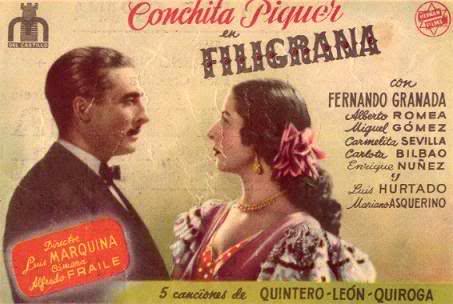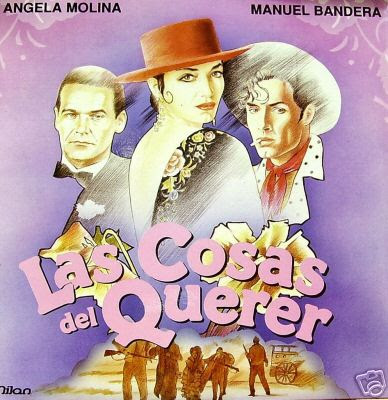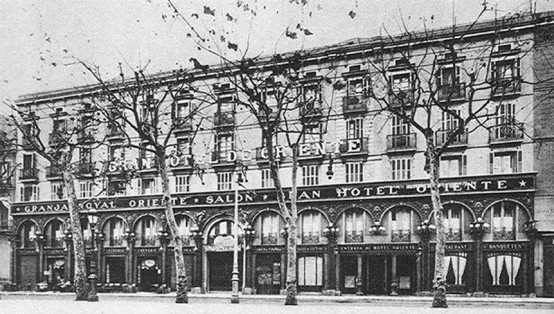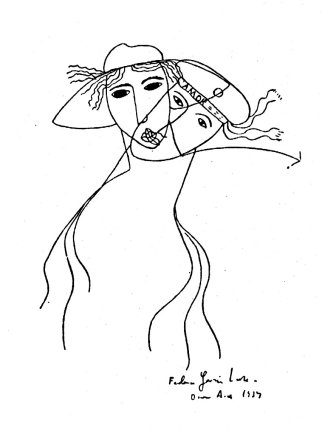Green Eyes
(Ojos verdes)
We knew when dad was happy in the mornings. He used to sing the songs he learned from grandma Chiquita (Petit), as we used to call her. Dad used to sing Ojos verdes, Green Eyes, one of the greatest coplas of all times. He said that Concha Piquer made this song known in the film Filigrana, Filigree, in 1949. As with any other great song, the genesis of Ojos verdes has its own legend and my dad’s account may not be have been the whole story.
I still remember the chorus that my father used to sing:
Ojos verdes, verdes como la albahaca.
Verdes como el trigo verde
y el verde, verde limón.
Ojos verdes, verdes, con brillo de faca,
que están clava(d)ítos en mi corazón.
Pa(ra) mí ya no hay soles, luceros ni luna,
no hay más que unos ojos que mi ví(d)a son.
Ojos verdes, verdes como la albahaca.
Verdes como el trigo verde
y el verde, verde limón.
— —
Green eyes, green as basil.
Green like the green wheat
and the green, green lime.
Green eyes, green, with the brightness of a dagger,
They are nailed in my heart.
For me there are no suns, constellations or moons,
There is nothing else than those green eyes that are my life
Green eyes, green as basil.
Green like the green wheat
and the green, green lime. [1]
In 1989, I heard a new version of Ojos verdes by Manuel Banderas, in the film Las cosas del querer, The Things of Love. The screening awoke my curiosity as to who could have inspired such a masterpiece of Spanish music. To see a clip of Manuel Bandera’s version please click here.
In 1990, fifty years after his exile from Spain, Miguel de Molina (1908 – 1993), one of the most renowned Spanish copla singers revealed, during an interview to the Spanish channel Canal Sur, significant details of the very first moments when the lyrics of Ojos Verdes were written [2].
Three great artists frequented the Café La Granja Oriente in Barcelona during the turbulent times of the Spanish Republic in the 1930’s. Who were they? A singer and dancer, a talented poet and a well known lyricist of the 1927 Generation: Miguel de Molina, Federico García Lorca (1898 – 1936) and Rafael de León (1908 – 1982).
According to de Molina, the lyrics of Ojos verdes were drafted the same evening after the premiere of the play by Federico García Lorca: Doña Rosita La Soltera, ‘Lady Rose the Spinster’, performed by the company Margarita Xirgu, at the Teatro Principal, in Barcelona, on 13 December 1935.
Rafael de León arrived at the Café La Granja Oriente and he started to tell a story of sailors and of green eyes to Federico García Lorca and Miguel de Molina. It appears that Rafael de León started to draft the lyrics, until Lorca stated: ‘But Rafael you are plagiarizing me’’. Lorca was referring to his own poem Romance Sonámbulo [3].
Rafael de León replied to Lorca ‘son, you have not invented the colour green’. Despite the friendly disagreement between Rafael de León and Federico García Lorca, they started to play with words and Rafael de León began the drafting of what would become one of the greatest coplas of all times.
Miguel de Molina interrupted Rafael de León joyfully, demanding that as he was the first person to witness the creation of Ojos verdes, he would like to be the first to perform this song’ [4].
The interview given by de Molina sheds some light on who inspired Rafael de León to write the lyrics of Ojos Verdes. It is said that there are at least three versions of Ojos Verdes. This first version, the original, was in the masculine form and sung by a man to a man. I believe, for obvious reasons, this version was never recorded nor performed live.
In the end, Miguel de Molina was not the first to sing this song, at least on stage or in a film. There are many accounts as to who was the first to perform Ojos verdes. However, the most popular versions were recorded by Concha Piquet and later by Miguel Molina himself. Only available in Spanish and without subtitles, to see Concha Piquet version please click here and for the Miguel Molina version please click here.
Manuel Quiroga, one of the music composers of Ojos verdes, proudly stated at the end of his life that it was the best song he had composed. It is said that it was him who offered the song to Concha Piquer, who after reading it asked him, ‘Don’t you think that there is a lot of green in here?’. Quiroga replied : ‘No, Conchita , it is not too much green, it is a beautiful repetition’ [5].
To understand why the lyrics of Ojos verdes were self-censored by its creators we have to put this song into the context of the Spain of the 1930/40’s and the emergence of General Franco. After 1940 the Franco censorship would forbid use of the term “la mancebía”[6] in Ojos verdes, replacing this word by “de mi puerta un día”.
Did my dad and the people of his generation know about the genesis of this song? I doubt they ever realised that the song they sung was related to “the love that dare not speak its name”. Regardless of who was the subject that inspired this lyric, this is a song that teaches us about the universality of love, lust, passion and poetry.
August 2015
— —
Footnotes:
[1] Free translation of the chorus to Ojos verdes.
[2] This was the only interview given to Spanish television, fifty years after Miguel de Molina was exiled from Spain. The complete interview given by Miguel de Molina to the Spanish channel, Canal Sur, in 1990, can be found in YouTube. Only available in Spanish to see the interview please click here.
[3] Federico García Lorca, Romance sonámbulo, from Romancero gitano, 1928. Below there is a fragment of the poem and a free translation.
Verde que te quiero verde.
Verde viento. Verdes ramas.
El barco sobre la mar
y el caballo en la montaña.
— —
Green, I want you green.
Green wind. Green branches.
The ship on the sea
and the horse on the mountain.
[4] Free translation from the interview given by Miguel de Molina in 1990, to Spanish channel, Canal Sur, ibid.
[5] Free translation from: Concha Piquer le preguntó: “Maestro, ¿no le parece a usted mucho verde, mucho verde?”. A lo que le contestó Quiroga: “No, Conchita; ¡qué va a ser mucho verde! Es una redundancia muy bonita”.
[6] The term mancebía has many meanings and some of them have sexual connotations such as dishonest fun, to live in sin without marrying and brothel, to name just three.
10 responses to “Green Eyes”
Trackbacks / Pingbacks
- - 23/09/2015





otra
LikeLiked by 1 person
¡Gracias Hugo!
There are many versions of this song in YouTube. I like the Concha Buika version:
LikeLiked by 2 people
Reblogged this on ' Ace History News ' and commented:
Nice post Adrian nice to see you back.
LikeLike
Thank you
LikeLiked by 1 person
Adrián, apenas si mencionas Las cosas del querer, ¿será que escribirás also sobre esa película en el futuro?
LikeLiked by 2 people
Me gustaría saber más sobre la canción Las cosas del querer … can you help?
LikeLiked by 1 person
¡Muchas gracias! Podemos hablar sobre la canción y la película Las cosas del querer esta semana y luego escribir un blog. ¡Es una muy buena idea!
LikeLiked by 1 person
Thank you. I started with the third article (La Copla) and then came back to read this one.
It was very powerful and a pleasure to watch. Also painful because of the catcalling and the jealousy and anger.
I am trying to understand the context of the scene:
– What was the relationship of the singer to the young man in the audience who was shot?
– Who was the man who shot him?
Many thanks for a great subject matter expressed with such care.
LikeLiked by 1 person
Hi David,
The film The Things of Love is a beautiful piece of work and it has a great resemblance to the life of Miguel de Molina.
I believe the event you refer to is a small vignette and it is fictional; too small to find a detailed explanation about who are the characters involved in the scene.
It portrays the magnetism of Mario within his audience (something that is attributed to Miguel de Molina too). It shows Mario’s charisma amongst his fans and the passion that he can arouse.
Thank you very much for looking at these blogs with such interest, David. Besides this interesting detail of the film, there are a wealth of songs that portray a period of Spanish history that we should not forget. In addition, I recommend the film as an interesting tool for Spanish language students.
Kind regards and thank you again.
Adrián
LikeLike